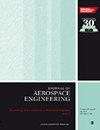Multi-objective multidisciplinary design optimization of liquid-propellant engines thrust chamber based on a surrogate model
IF 1.1
4区 工程技术
Q3 ENGINEERING, AEROSPACE
Proceedings of the Institution of Mechanical Engineers Part G-Journal of Aerospace Engineering
Pub Date : 2023-08-18
DOI:10.1177/09544100231182268
引用次数: 0
Abstract
The design of liquid-propellant engines (LPEs) has several challenges in setting the performance parameters. Accordingly, optimizing the design of a thrust chamber is of considerable importance that has been considered in several research projects. Previous research has focused on multidisciplinary design optimization (MDO). However, despite these efforts, the main issues remain. The present paper proposes a multi-objective multidisciplinary design optimization based on an efficient adaptive surrogate model of the thrust chamber to address these issues. The proposed method introduces a practical multidisciplinary optimization method based on an adaptive surrogate model that uses the moving least squares methodology, CCM, sensitivity analysis, and the elite multi-objective genetic algorithm (NSGAII). Due to the high importance of specific impulse and thrust-to-weight ratio, these two functions were used as target functions and in the NSGAII framework, the Pareto frontier was drawn for them. The proposed method is applied to a thrust-chamber engine test case. The results show that the target performance of the engine is improved, the specific impulse value is increased by 3.4 s, and the thrust-to-weight ratio is increased by 4%. These values represent significant advances in LPE engine design. The results obtained in this study indicate the potential of the proposed method in solving large-scale thrust-chamber design optimization problems.基于代理模型的液体推进剂发动机推力室多目标多学科设计优化
液体推进剂发动机的设计在性能参数的设定方面面临着诸多挑战。因此,推力室的优化设计是一个非常重要的问题,已经在一些研究项目中得到了考虑。以往的研究主要集中在多学科设计优化(MDO)方面。然而,尽管做出了这些努力,主要问题仍然存在。本文提出了一种基于高效自适应代理模型的推力室多目标多学科优化设计方法。该方法引入了一种实用的多学科优化方法,该方法基于自适应代理模型,使用移动最小二乘方法、CCM、灵敏度分析和精英多目标遗传算法(NSGAII)。考虑到比冲和推重比的重要性,我们将这两个函数作为目标函数,并在NSGAII框架中为它们绘制了Pareto边界。将该方法应用于某推力室发动机试验实例。结果表明,该发动机的目标性能得到改善,比冲值提高了3.4 s,推重比提高了4%。这些数值代表了LPE发动机设计的重大进步。研究结果表明,该方法在解决大型推力室设计优化问题方面具有很大的潜力。
本文章由计算机程序翻译,如有差异,请以英文原文为准。
求助全文
约1分钟内获得全文
求助全文
来源期刊

CiteScore
2.40
自引率
18.20%
发文量
212
审稿时长
5.7 months
期刊介绍:
The Journal of Aerospace Engineering is dedicated to the publication of high quality research in all branches of applied sciences and technology dealing with aircraft and spacecraft, and their support systems. "Our authorship is truly international and all efforts are made to ensure that each paper is presented in the best possible way and reaches a wide audience.
"The Editorial Board is composed of recognized experts representing the technical communities of fifteen countries. The Board Members work in close cooperation with the editors, reviewers, and authors to achieve a consistent standard of well written and presented papers."Professor Rodrigo Martinez-Val, Universidad Politécnica de Madrid, Spain
This journal is a member of the Committee on Publication Ethics (COPE).
 求助内容:
求助内容: 应助结果提醒方式:
应助结果提醒方式:


